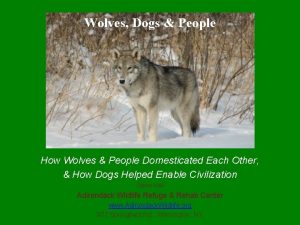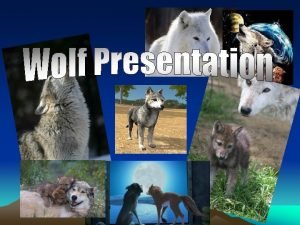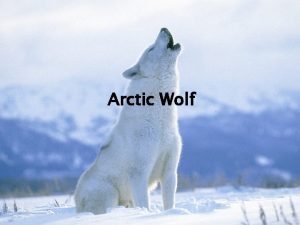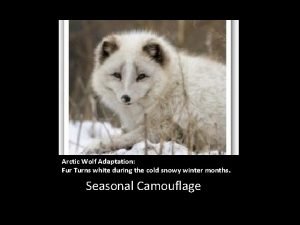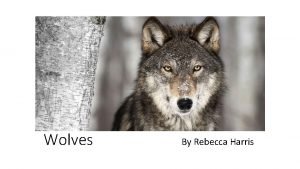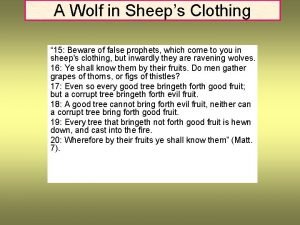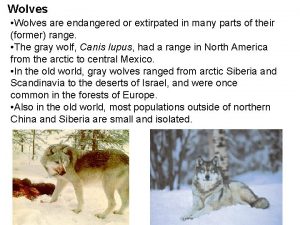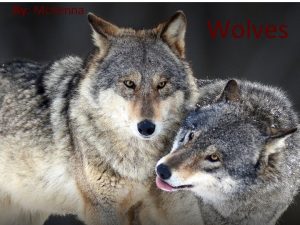Wolves and Dogs Fact and Fiction n n

































- Slides: 33

Wolves and Dogs: Fact and Fiction

n n Think you know where dogs came from? How much they have in common with their ancestors? Or what they're really trying to tell you when they bark? Take this quiz and find out.

Dogs are descended mostly from wolves, jackals, and coyotes.

Nope, try False.

n Yep. It's false. Dogs were long believed to have descended from several species, including the wolf and jackal. Recent scientific analysis of dogs, however, has upheld the more current theory that the dog's primary ancestor is, indeed, the wolf, Canis lupus.

The dog was the first animal to be domesticated by humans.

n Yep. True. According to archaeological records, the dog was the first animal to be domesticated (from a wolf), sometime around the end of the Ice Age.

Nope, it's true.

The dog was first domesticated in the early 1500 s.

Nope. Check out False for the real truth.

n That's right. False. To date, the first domesticated dog was found at a German site dated 14, 000 B. C. Dogs were thought to work cooperatively with humans to locate and announce the position of prey wounded by hunters' primitive arrows. A recent study in the journal Science, however--which looked at mitochondrial DNA from dogs, wolves, coyotes, and jackals--concluded that wolves and dogs may have genetically diverged much earlier, as long as 135, 000 years ago.

There about 40 species in the dog family, Canidae.

n Correct. There are 38 species in the dog family, Canidae, of which dogs and wolves only comprise a small percentage. Jackals, foxes, and zorros make up the majority. There is only one species of fully domesticated dog, Canis familiaris.

Nope. Try True to learn more.

About 80 breeds of domesticated dogs exist today.

n No. There's a lot more than 80. See False for more information.

n Because dogs have undergone a number of changes due to natural selection--and have also changed drastically through artificial selection for hair color, size, and temperament--there about 200 to 400 breeds worldwide. The American Kennel Club recognizes 140 breeds, defining a breed as a "relatively homogeneous group of animals within a species, developed and maintained by man. "

An adult dog and wolf of the same weight will have differentsized heads.

n Yes. A dog of the same weight as a wolf will have a head that is 20 percent smaller. This is a result of several factors that occurred during domestication of the animal. Dog heads vary from wolf heads in several other ways as well--they feature smaller teeth, more rounded and forwardlooking eyes, and a more curved lower jaw.

n No, strange as it may seem it's true. Look there for more.

Dogs and wolves bark for some of the same reasons.

n Definitely. Dogs and wolves share barks that indicate alarm and intruders. Yet dogs also seem to bark at times for no readily identifiable reason -- researchers don't know whether these barks are for communication or are for some other unknown reason.

n Not quite. Look to True for more

Dogs and wolves rely equally on visual communication.

n No. Why don't you try False?

n Yep. While visual communication--such as the position of ears, tail, and lips--is important among wolves it is believed to be less relied on by dogs. Selective breeding among dogs has produced species with drooping ears, lobbed tails, and long coats that are less effective in performing traditional dominant-submissive wolf and dog behaviors; examples include ears up or pinned back, tail straight behind or tucked between legs, or raised or lowered hackles. Domestic dogs are thought to rely more on olfactory senses.

Wolf hybrids must be licensed and vaccinated for rabies.

n You bet. But while a wolf hybrid is considered a dog, and therefore must be licensed and vaccinated, there is currently no USDA-approved vaccine for these animals. Many wolf hybrids are vaccinated with the dog vaccine, but because of the lack of a federal approval for this serum, a wolf hybrid may be treated differently from a dog if it bites a human.

n Not quite. Try True.

You can't teach an old dog new tricks.

n Think again. And try False for some help

n Yep. You can, but stick with teaching a younger one--it's usually easier. And stay away from trying to teach wolves any tricks --they are wild animals and can be very unpredictable.

 Mountains sia
Mountains sia Elements of nonfiction prose
Elements of nonfiction prose Realistic fiction
Realistic fiction The genre of speculative fiction
The genre of speculative fiction Contemporary realistic fiction vs historical fiction
Contemporary realistic fiction vs historical fiction Evolution fact or fiction
Evolution fact or fiction Wolves and deer
Wolves and deer St lucys home raised by wolves questions and answers
St lucys home raised by wolves questions and answers How to write wolf in cursive
How to write wolf in cursive Red timber wolf
Red timber wolf Singular and plural
Singular and plural Outlearning the wolves
Outlearning the wolves What do arctic wolves look like
What do arctic wolves look like Flaps of featherless skin between their front and back legs
Flaps of featherless skin between their front and back legs Wolves
Wolves Db drills
Db drills Beware of wolves in sheep clothing
Beware of wolves in sheep clothing Stars citizens lone wolves apathetics
Stars citizens lone wolves apathetics Lycanthropic culture shock
Lycanthropic culture shock Wolves hunting caribou
Wolves hunting caribou Plural possessive of wolf
Plural possessive of wolf Dancing with wolves movie
Dancing with wolves movie Kazuma
Kazuma Wolves vagan
Wolves vagan Personification figure of speech meaning
Personification figure of speech meaning Ticks and dog relationship
Ticks and dog relationship As i was saying by augustus gluten
As i was saying by augustus gluten Hrt to hrt merrylands
Hrt to hrt merrylands Intramuscular injection sites in dogs and cats
Intramuscular injection sites in dogs and cats What is hyperbole in figure of speech
What is hyperbole in figure of speech Maine coon and dogs
Maine coon and dogs Caravanpack.esm
Caravanpack.esm Algebra 1 bootcamp
Algebra 1 bootcamp Dogs trust values
Dogs trust values
